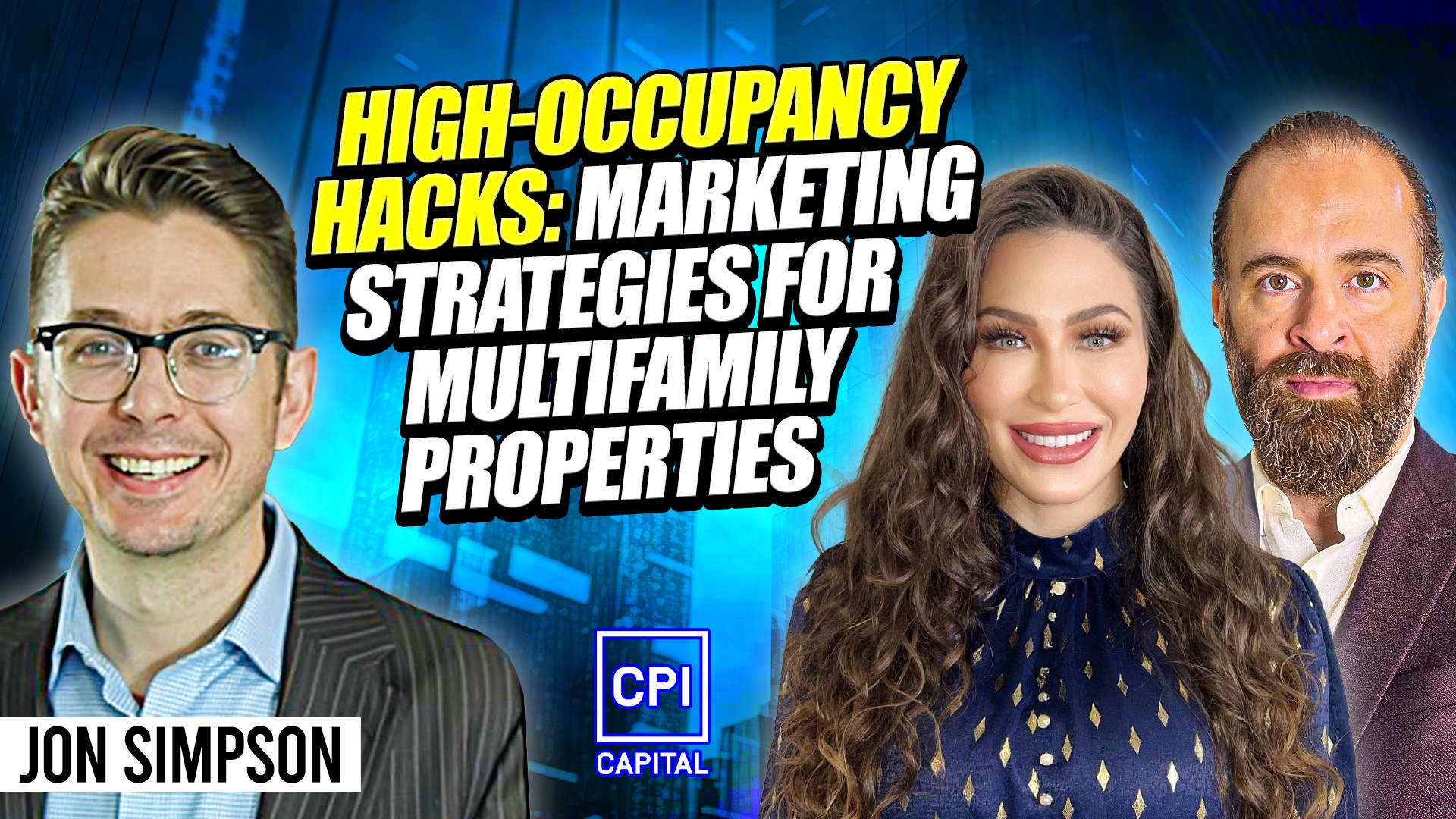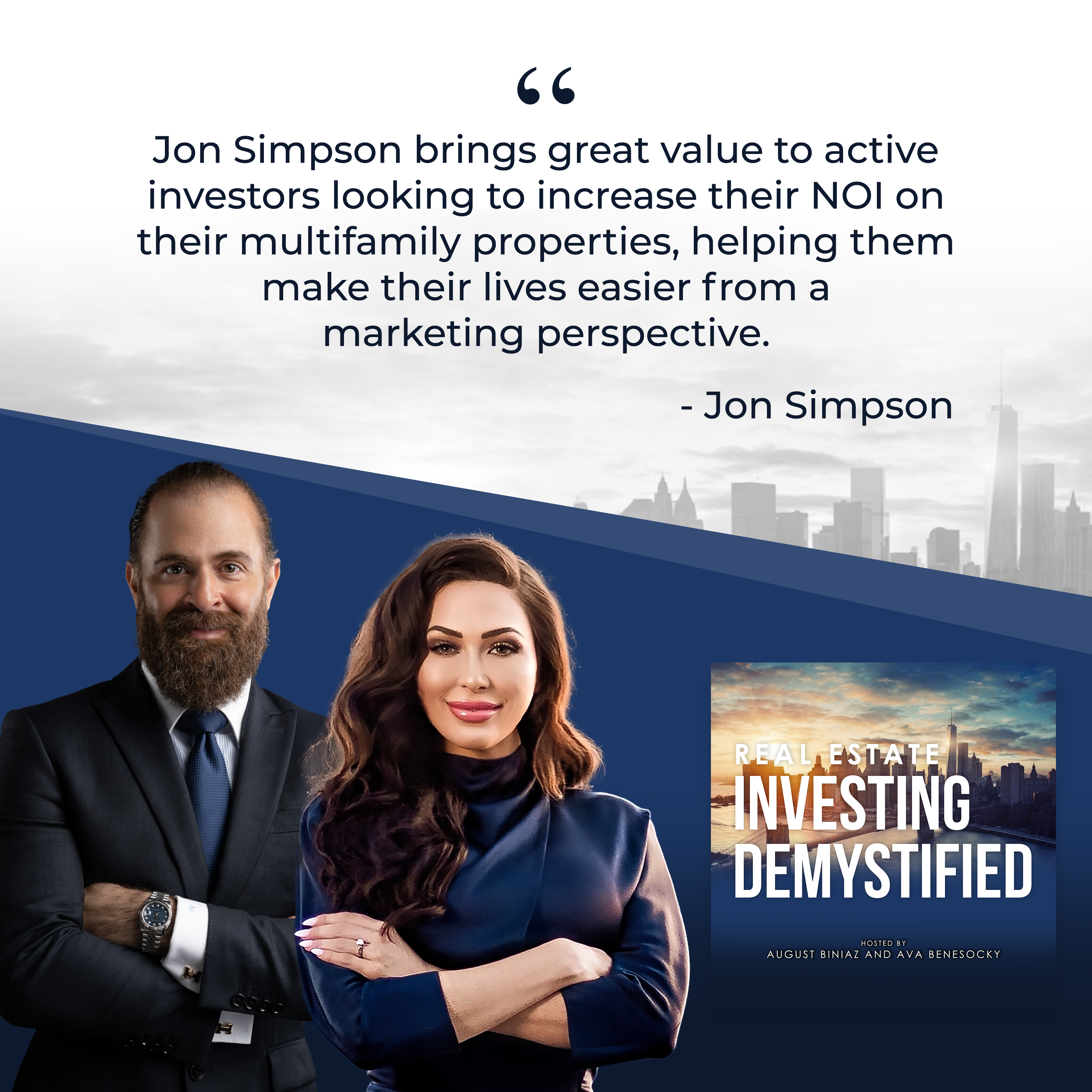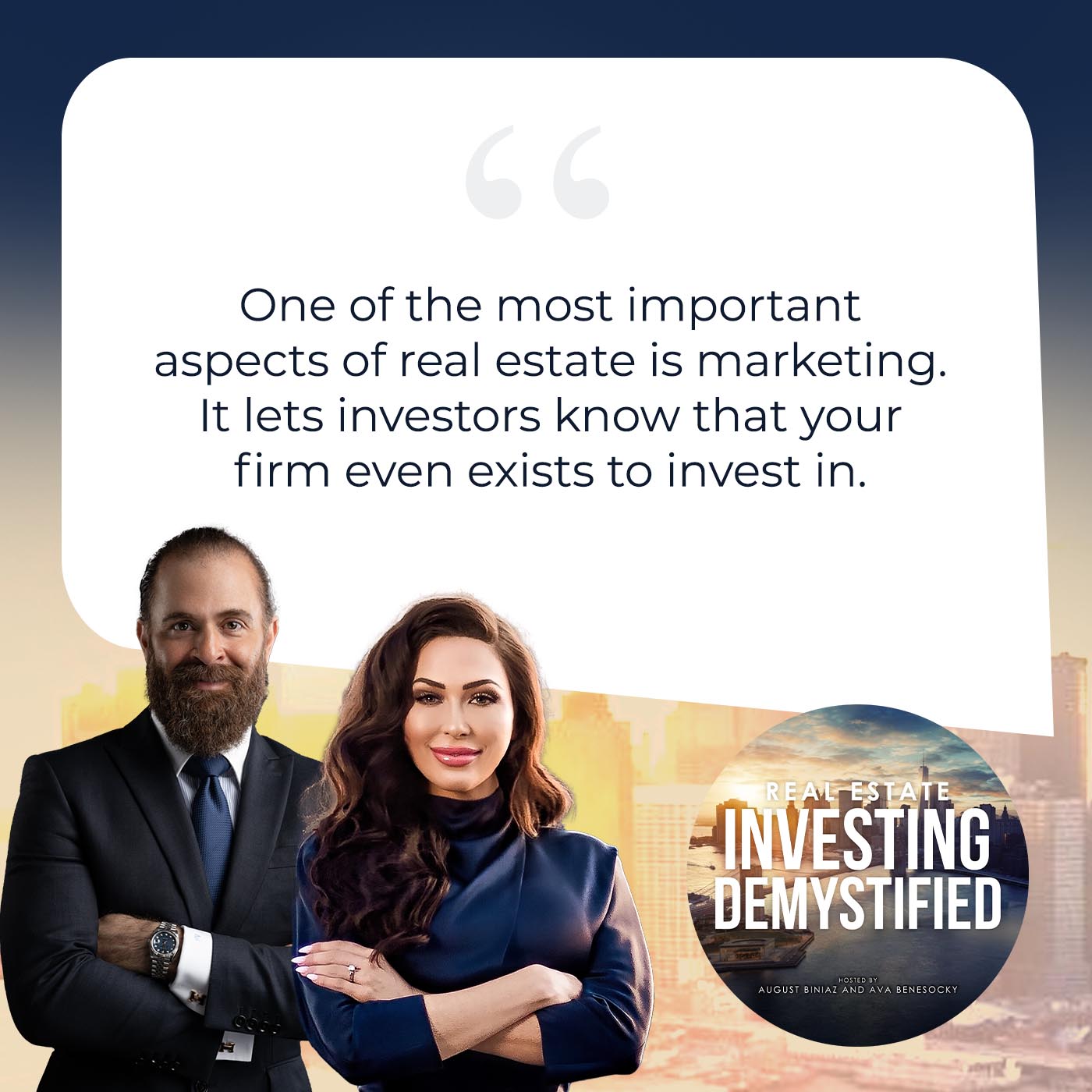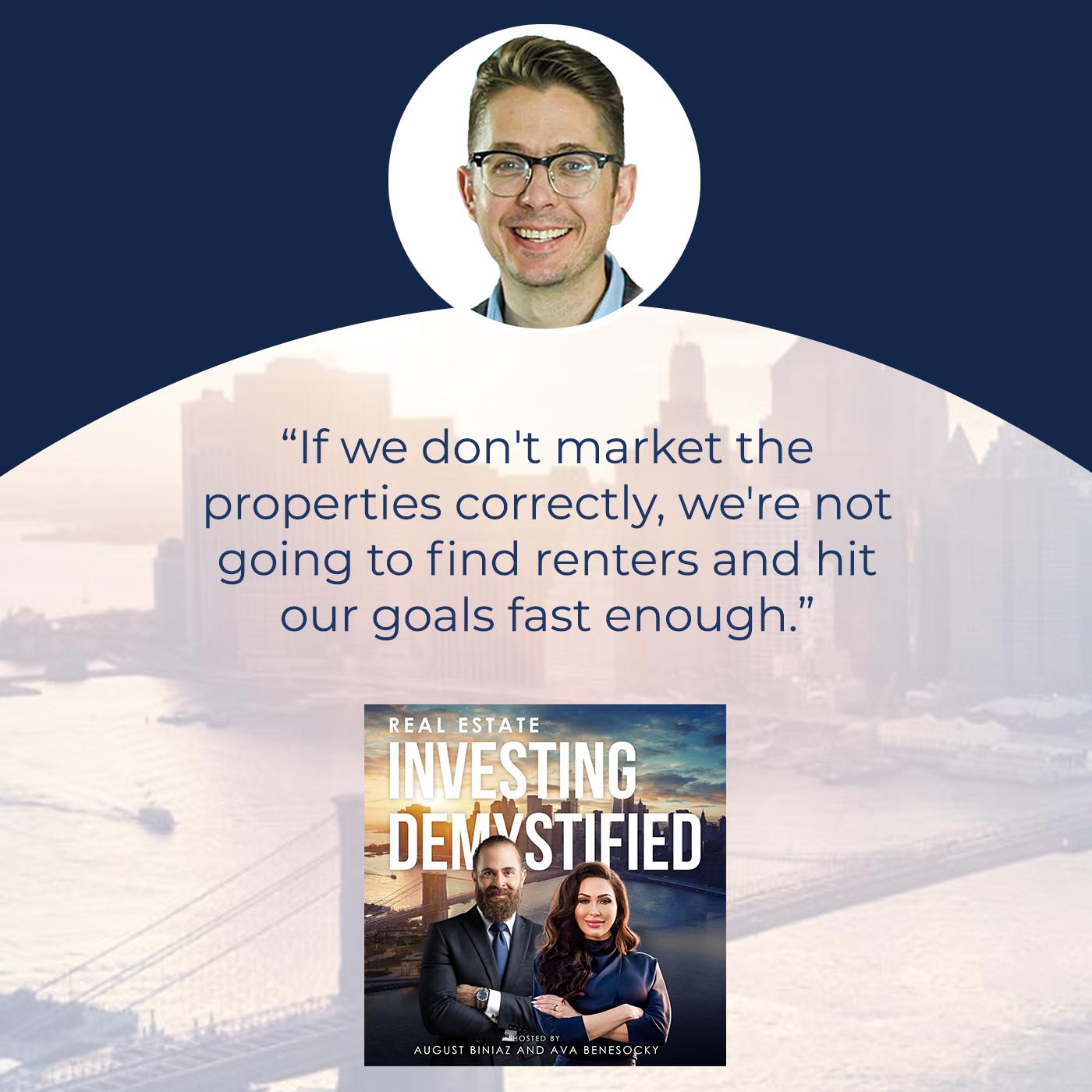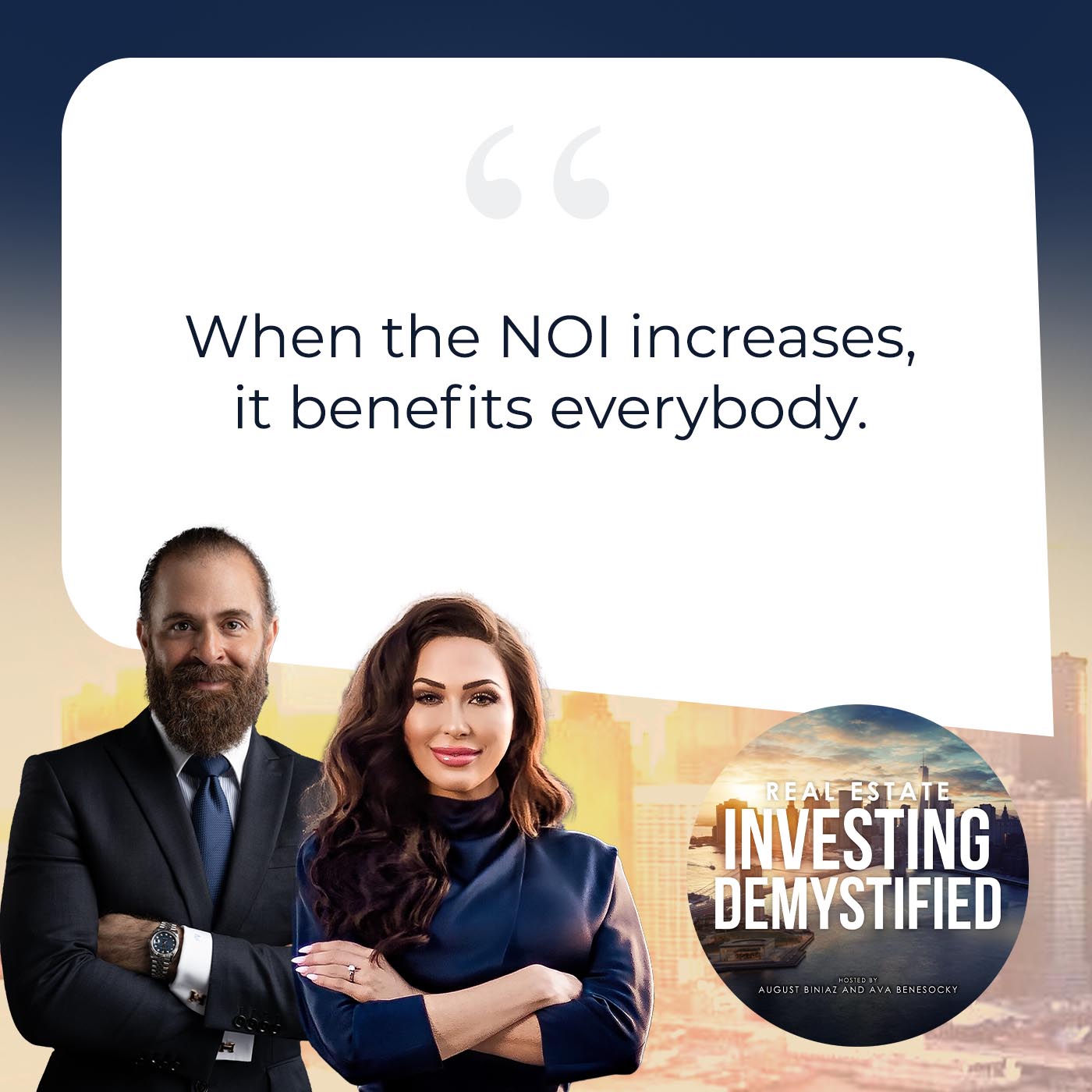If you’re not putting time and effort into your business’ marketing, then you’re missing a lot. Even in the multifamily industry, ensuring you have a strong marketing strategy could be the difference between thriving and losing out. This episode’s guest saw a need for more effective and efficient digital marketing support in the industry, leading him to start multiple businesses including Swifty and Criterion.B. Jon Simpson joins Ava Benesocky and August Biniaz to share marketing strategies for multifamily properties, breaking down the ways you can hit high-occupancy so you can get the best price for your property. He discusses the key things to help you build a marketing plan, drive qualified traffic, and take your property from distress to stabilization as fast as possible. From fixing your Google Business Profile to creating a website to utilizing social media, Jon covers them all and more. So tune in to not miss out on these great marketing hacks!
Get in touch with Jon Simpson:
LinkedIn: https://www.linkedin.com/in/jonosimpson
Swifty: https://beswifty.com
Criterion.B: https://criterionb.com
If you are interested in learning more about passively investing in multifamily & Build-to-Rent properties, click here to schedule a call with the CPI Capital Team or contact us at info@cpicapital.ca. If you like to Co-Syndicate and close on larger deals as a General Partner, click here. You can read more about CPI Capital at https://www.cpicapital.ca/.
#avabenesocky #augustbiniaz #cpicapital
—
Watch the episode here
Listen to the podcast here
Important Links
- Criterion.B
- Swifty
- ResMan
- Apartments.com
- Rent.com
- Apartment Life
- Knock
- Anyone Home
- Think and Grow Rich
About Jon Simpson

High-Occupancy Hacks: Marketing Strategies For Multifamily Properties With Jon Simpson
Welcome back to the show.
This show is mystifying real estate because there are so many different businesses within the real estate world. I thought I knew everything about real estate. I thought I was Mr. Know-It-All until I got involved in real estate private equity and realized I didn’t know much.
It’s going to be a forever or lifetime learning journey.
I’ll say I’m getting pretty close to the peak here.
August likes to nerd out all the time every day all day.
Continued education is always very important. When you understand the basics of real estate, private equity, and capital raising, you understand whatever asset classes you’re focused on. In our case, it’s a multifamily. If you understand the business model, it is a value-add. Keeping up with what’s happening with the market is the most important thing. We’re in mid-August 2023. Real estate has four cycles. You have a recovery, expansion, hyper-supply, and recession. We’re in that recession phase of the market, that’s what I would guess.
Internally as a team means equals the buying stage.
Internally as a team means that we got lucky with all kinds of luck that exists that we didn’t close on a deal for 2022 because there is distress.
We’ve been thanking the universe pretty much every day on a daily basis. We’re so grateful for the position that we’re in at CPI Capital here.
We want to allocate that this was all because of my personal genius that we didn’t close on a deal but some of it was luck. It turned out that we were eager to do a deal but things weren’t making sense. There were a lot of concerns.
At CPI Capital, we don’t have to do a deal to keep the lights on. We were very hyper-cautious and selective. We decided to sit back as there was so much turbulence in the market. It served us and our investors.
Coming to the market, we’ve been working on our investor database, investor communications, and investor nurture. Investors are calling us saying, “Do we have a deal? What’s happening?” We’re seeing some distress in the market so we’re excited to get into the market and buy properties that were bought at $200,000 a door. Now, they’re coming to the market at $150,000 a door.
It’s unbelievable. I have my finger on the pulse of investors and they are calling. There are back-to-back meetings with investors. Investor sentiment is getting better every day so we’re excited about it.
A very important part of our business is marketing. We’re excited about our guest for this episode. A quick thing about our guest. We’ve met our guest at many of the conferences we’ve gone to. He’s always energetic and positive. He always has a smile on his face. We are excited to have him on. We got to ask him to forgive us because it was a long time coming that we were going to get him on our show. It’s a segment of the business that doesn’t get a lot of attention but it’s one of the most important parts of the business.
That’s marketing.
We’re going to break that down. What do we mean by marketing? Ava, go ahead and tell our audience about our guest.
In this episode, we’re joined by Jon Simpson. He is the Founder and CEO of Criterion.B, a dynamic marketing agency based in Dallas that focuses on serving the multifamily industry. He launched the company in 2007 and chose to focus specifically on multifamily in 2017 because he saw that owners, developers, and vendors had a need for more effective and efficient digital marketing support. Not stopping there, in 2020 he launched Swifty, an affordable multifamily marketing platform that makes it incredibly easy for owners to create websites for their properties and execute all of their online marketing needs in less time.
In 2022, he took the next step and became a multifamily investor himself to first-hand experience the struggles partners face so he can better serve his clients. We believe this interview with Jon will bring great value to active investors looking to increase their NOI on their multifamily properties. Jon, welcome to the show. Thank you for being here.
Thank you for having me. This is awesome. I’ve been looking forward to it for all those months that I’ve been waiting to be on the show. We’re good.
Jon, you have many years of experience in marketing but could you tell us about when and why your focus switched to real estate marketing, particularly multifamily?
We were a marketing agency for ad agencies doing all of their digital work. We were the lowest man on the totem pole. We were doing all the grunt work and programming. We got to work on some amazing projects but we were tired of always being last. We caught the brunt of all the crap that runs down the hill from above us. We looked around. At that point, we had already built Hamleys’ corporate website through an agency.
We had built some projects for UDR and done some stuff like that. There were a million cranes in Dallas. We said, “We need to pick a niche. Let’s pick construction. There’s so much going on in this space.” Where our focus shifted was to try to take ownership of the work and our clients and to stop being the lowest on the totem pole there. Dallas is a huge construction market.
Dallas is also a huge market for multifamily, particularly syndication. There were big names like Brad Sumrok and Mark Kenney of the world. Many others have started from Dallas and grown their businesses. It has a big multifamily fraternity there in Dallas. Going back to this topic of marketing, marketing in our opinion is one of the most important aspects of real estate private equity.
In the process of syndicating deals, marketing is very important to be top of the funnel, bring investors in, and know that your firm even exists for them to invest with you. Our focus here at CPI was marketing, building a brand around ourselves and the company, connecting with investors, and creating a lot of content online like this show. That’s a very important part.
Being on the operations side of the business, we realize that marketing is also very important when it comes to post-closing. After you’ve purchased an asset, you’re there to execute the business plan. There needs to be a level of marketing to get your clients, which are your tenants, to come to your building for you to be able to increase your rents and occupancy. That’s the basic part of our conversation with you. Maybe you could give us a crash course on a syndicator or an investor who purchases the multifamily property. They’re taking it over at one point you get involved. Walk us through that whole journey.
We help developers from ground zero. Some of our developer clients will contact us before they’ve even purchased the land that they’re going to be building on. We get involved as early as we can. We work with their interior design and architectural firms. A lot of the stuff that we do for our clients affects everything from the ironwork that might be on the balconies to the rugs they choose and the fabrics they pick out for their clubhouses, everything from that level for our ground-up development.
When you’re talking about ground-up development, is this for build-to-sell product or build-to-rent?
Most of this is going to be multifamily apartment complexes so class A developments. We work on these all over the country. Oftentimes, they’re buying the land and building either a high-rise or garden-style. It could be a mid-rise. Whatever it is that they’re working on, they try to get us involved as early as the architects because we do the brand, the coloring, and all of that side of the building process. Sometimes we’re involved in months or years before they’re built. We’re working on a project in downtown Dallas and Plano, Texas.
That started in 2015. Construction didn’t start until 2018. The launch of the building was in March 2020, right when COVID hit. We worked on that project from day one, naming it, designing the logo for it, and then handling all of the construction banners through monument signage, interior signage, and everything for that development. Also, the groundbreaking ceremony, the grand opening party, and all of the different pieces of it. One project like that could last 8 to 10 years. We’re still working on it. We still do all the social media for that building as well. Class A new development is a different beast altogether.
A lot of the audiences are going to be doing a lot of the value-add and hybrid type of purchases where you’re looking for those Class Bs and Cs, upgrading them, leasing them up, and then looking for the next buyer for that property. For those, we typically are going to get involved as early as we can, which is typically during due diligence. Before they’re purchased, there are no marketing dollars being spent at that point but educating and learning the things that you should be looking for. What are the things that you should be doing from a marketing perspective, even in due diligence? How do you build a marketing plan and all that kind of stuff around this property you’re about to buy?
When you get involved in that early stage, you could also see losses or where the current owner is not utilizing certain aspects of marketing to bring in more clients and tenants saying, “These guys don’t even have a website. These guys’ website is not very comprehensive.” There could be ways where you can see inefficiencies and tell us, “If our team takes over, we’re going to help your occupancy and get a better type of tenant in there as well.” That would be an aspect as well.
We have a bunch of different checklists. We have a due diligence marketing checklist, pre-closing marketing checklist, closing marketing checklist, and post-closing marketing checklist. With these different tools, all you have to do is carry it with you when you do due diligence. What do the signs look like? Are we going to rename the property? Are we going to need to rebrand the property? Are we going to need new and more way-finding signs? Do people know where the leasing office is? All these types of things that are for your benefit so you know, “These are all the stuff I’m going to have to update or change once we purchase the property.”
You’re involved in every aspect of that. Bringing the cart before the horse, your packages also include that where you get involved, do all of that, and it encompasses everything.
It can. It depends on what level you hire us at. For Swifty clients, we make resources like these checklists available for you. It is a self-service platform. When you’re leveraging us, Swifty is a website, AdWords, and Google business tool. Those are the three things we do. I’m happy to have phone calls. I love talking about marketing. I’m happy to talk to anybody about it, brainstorm with you, and give you some ideas.
With Swifty, you’re going to get those three digital assets. We have lots of resources for you that are free that you can download and use. Criterion.B is a white glove marketing agent service. You’re going to pay for the experience but at the end of the day, we do a lot of handholding and the work for you that I’m talking about.
Jon, you would be doing that in conjunction with the property manager in most cases.
You brought up a good point about marketing departments within property management companies. We work with a lot of directors of marketing of these big PMs. When you think about it, their marketing departments are project managers of the marketing piece of the marketing for these properties. You have one director of marketing who might have over 70 properties. No human can handle the marketing for 70 properties on their own. They’re leveraging companies like myself or others to do a lot of the parts of that marketing for those individual properties.
We find no fault of their own but they are some of the most stressed out people we’ve ever met in our life, these marketing managers. If you are managing 70 properties, that means you have 70 managers asking you for all the collateral materials, website updates, uniforms, and all these different things that they need. When you have 70 people asking you for stuff every day, it’s hard to stay on top of it. We develop systems and plans to help them manage that process and have less stress in their lives. That’s my goal as a business owner and why we started Swifty.
We saw our clients who are these marketing directors, how frazzled they are. They’re traveling all over the country trying to make every grand opening or visit all their properties. They’re having a hard time with it. We’re like, “How can I make your life easier? What can I do from a marketing perspective to make your life easier?” There’s a lot of stuff I can’t do for them but when it comes to marketing, there’s a lot we can do. That’s where Swifty was born.
We’re in that recession phase of the market. There are lots of deals that are coming into that distressed territory. Investors and property owners are talking with their broker or property manager about the situation they’re in. Would you be involved at some point saying, “We need you to push the marketing or get some more Google AdWords,” or however you guys do your thing? “We need to get the occupancy higher here over the next few months because we’re trying to sell.” Do you get involved in those stages as well when there’s a need for you to increase, not just to maintain?
Yes. The presentation will go into a lot of that on how they can continue to drive their occupancy rates up. Everybody wants to hit that 95% or 96% occupancy rate to get stabilized so they can get the best price for their property. There are lots of factors in there, primarily from driving-qualified prospects. We do that through Google AdWords and Google Business.
Everybody wants to hit that 95-96% occupancy rate to get stabilized so they can get the best price for their property. Share on XThat’s all for naught if you don’t have a good website that will convert those people into actual leads. It’s going to be very important to have a stellar leasing team because even if the marketing is amazing, the goal is still to drive prospects to your leasing team to close the deal. You do need to have a good leasing team but hand in hand with good marketing, you’ll be able to get at least up.
A little bit about me real quick to expound on what August had mentioned. I’ve owned a marketing agency for several years. I’ve been in marketing for longer than that. We’ve been serving multifamily for a decade. I have a love for multifamily. As I’ve gotten to know it every year, I put all of my eggs in that basket. More every year, we’re focused on this in all aspects.
With Criterion.B, we work with anybody that touches multifamily. We’ve worked with ResMan. We did all of ResMan’s branding and marketing for many years. We worked with lenders and service-based companies. Anybody that touches the industry that’s trying to get in front of multifamily, we help them do that. We’ve worked with properties from coast to coast, North to South.
We pretty much have worked with all sizes and shapes of properties. We love working in multifamily. We get to go all over the country. We go to grand openings, events, and association events. I see them at most of the different conferences I go to. It’s at least once a month, it seems like, that I’m out of the state going to visit these. These are the different grand openings, visiting clients, and all of that that we did.
What I want to talk about are three things about your marketing. A) The path is how we’re going to drive prospects and qualified traffic to your site. B) The story, what we want to tell them once they get there. C) The lease. The end goal for everybody is to get as many leases as we can get. The problems that we face, whenever I’ve talked to owners or managers, are all pretty much the same. It’s their lack of marketing knowledge. “I need to lease apartments. What am I doing wrong? I’ve been doing this for a long time. We’re in a different market. It’s a tough market. What do I not know? How can I fix that?”
The low rate of conversion. I’m seeing a lot of people but nobody’s buying. We want to help you through that. The ROI for investors seems to be a big one. All of our GPs and leads that we talk to are responsible for your money. They want to make sure they’re not disappointing you. How do we help them do that? If we don’t solve these problems and don’t market the properties correctly, we’re not going to find renters and hit our goals fast enough. You’re going to have a bunch of frustrated people.
This is the old way. Most properties have a logo. You need a logo. I do want to emphasize that this is not the wrong way. This is just stuff the way we’ve done it forever. Logo. Maybe you have a website or don’t. Maybe you’re leaning on Apartments.com exclusively. Monument sign. Everybody can agree that you have to have a good monument sign for your property. Banners. It could be leasing banners. Facebook marketplace is pretty much a must. ILS, Apartments.com, and Rent.com.
For people who might not be too sophisticated, you’re talking about outside of their company. They might be owning ABC multifamily but when they buy a property in Florida somewhere, this is particularly to do with that property that you’re talking about that they’ve purchased under the market.
Specifically, yes. I will intertwine a couple of things specifically for your capital raising, personal brand, and stuff. The majority of this talk, the presentation I’m going through with you is going to be specifically related to your property. You bought a property and you’re trying to take it from distress to stabilization as fast as possible. It doesn’t matter where you’re located or where this property is located but this would be on a per-property basis. We want to help you reach stabilization in less time for these properties. You have to have the right technology in place to help you do that.
In the old way, you might do this through Wix, GoDaddy, WordPress, Squarespace, or Fiverr. Your sign guy may do it. We find that a lot, where they are getting help from whomever they can. Problems with these, none of these are built for multifamily. If you’re doing it yourself, you’re trying to save a buck and not use all your CapEx dollars or investors’ dollars on the marketing aspect of it. You’ll lose money every time you raise the hammer. Hire the right people to do the job for you and trust that they know what they’re doing.
There are tools out there, whether you’re using Swifty or one of my competitors. We have tools that are built specifically for multifamily. You need to leverage that. These sites are not tied to your PMS. Whether you use Yardi, ResMan, AppFolio, RealPage, Entrada, MRI, or any of those guys, by default, use Wix or GoDaddy. You’re going to do a lot of extra work to tie those in. With that said, your PMS systems do offer websites too. These websites that they offer are tied into their systems exclusively. If you ever switch PMS systems, you’ll also be forced to change your website over as well.
You can build a custom website very costly but they have all the bells and whistles. They also take longer to build. I’m going to show you at the end of this how Swifty can solve the problem for you very quickly. It’s less than 45 minutes that we can build a website. It gets you up and running fully functional, ties into your property management system, and you’re ready to go.
We’re going to jump right into the path of how you drive qualified traffic. This is being done in a couple of ways, both online and offline. You’re going to have a couple of things that I’m going to say. You need to be doing these. AdWords is a must. AdWords is an intent-based marketing mechanism. It means that your ads are not going to show up unless I type in the right thing. We can target our ads to only show very specific demographics. When you think about this, not just from an apartment standpoint but from a capital raising standpoint, you can say, “I only want to show my ads to accredited people and make sure I’m hitting this demographic in this area of the United States.”
You can be very strategic in how you approach your AdWords. When we’re running ads, you’re going to be driving qualified people. The nice thing here is the AdWords that we’re coming up with are going to be things like, “Apartments near Phoenix, Arizona,” things of that nature. The longer tail keywords we can come up with so the longer the phrases, and the more specific we are, the more qualified people we’re going to find.

Multifamily Properties Marketing Strategies: The longer the phrases and the more specific we are, the more qualified people we’re going to find.
It’s pay-per-click, meaning that you’re only going to pay when someone physically clicks. Our ads are going to show up for tens of thousands of people but we’re only paying when they click on it. That’s very important to know. The cost per click is going to be based on the keyword phrases. If I put in “Apartments,” that’s very expensive. If I put in “Apartments in Phoenix, Arizona,” we can get that cost per click way down to under $2 most of the time. It’s all things that we need to focus on.
The benefits. We get increased visibility. We’re only paying when they click. We can target specific audiences, create lists out of these audiences for future advertising as well, and adjust our daily spending to what we can afford. I would recommend nothing less than $500 a month on a media budget, meaning that’s how much you’re paying Google. We typically don’t see people the need to spend too much over $1,200 to $1,500 per month per property to get the right traffic. Have great reporting and you have the ability to see the conversions.
A real quick what sponsored is. You can only beat Apartments.com and the other ILS two ways in a Google search. The first way is going to be paid, meaning you’re buying it through Google AdWords. What you see here with the red box around it are the first five slots of any search. That’s all going to be paid for. After that, you can earn it in the next section, which is going to be Google Business. Other than that, organic is the last way and that’s where the ILS has us beat. I’m not going to spend too much time on that.
Carrie Clark is one of my clients. She had come to us and said she was at 67% occupancy. She runs and owns a property that has 40 units in Podunk, Texas. This tiny town in Texas has 67% occupancy. After she put a lot of these marketing practices in place, including AdWords, within six weeks, she was up to 100% occupied. It is something you can turn on and turn off. One person’s results are not guaranteed for anybody else but it shows that if you put sound marketing practices in place, they do work even in tertiary markets. Remember that.
Another paid mechanism is your ILS. This is a cost of doing business. You must do this. You don’t have to do Apartments.com. You can do rent, apartment list, or others but you need to do one because people do not randomly show up on Apartments.com. They have intent. Whenever you can be in front of an intent-based audience, you need to have a presence there. It’s very important.
Whereas, if you do ads on Facebook or other things like that, they aren’t asking for your ads. That’s disruptive marketing. You’re showing up in front of a lot of people but it’s like a billboard. You don’t know that they need an apartment. Apartments.com, rent, and apartment list, these ILS have a great audience for you so you need to be on them. All their pricing models are different so find one that’s affordable and in your budget. You need to do it.
Social media is unpaid. I don’t need to talk about it. Everybody knows you need to have a social media presence. In my opinion, social media is going to be more for your representation of your current residence, more so than your prospective residents. You need to build a community and a home. Allow them to build friendships at the community level. There’s no better retention than friendships. People like to live with their friends. If you can help build that community and those friendships, there are a lot of ways to do that. There are great people out there who can help you do that but you need to work on your community.

Multifamily Properties Marketing Strategies: Social media is going to be more for your representation to your current residence, more so than your prospective residence.
Unpaid. This is going to be SEO. We’re going to try to use one of August’s terms. We’re going to demystify it for you. SEO is not this magical thing that’s out there built only to confuse people. There is a big algorithm behind it that makes it weird and difficult to understand sometimes. We’re going to cut out half of that by saying that there are two types of SEO. There’s traditional, what I call national, and then there’s local.
For properties, we only care about local. If you have a property in Phoenix, it’s not competing with a property in Chicago, Florida, or anywhere else. You’re only competing within a 2-mile to 5-mile radius of your building. We need to be hyper-localized. Apartment lists and Apartments.com can beat us on the national level all day long, I don’t care. We’re not competing at that level. We don’t need to worry about it.
Quick question for you on the social media part. Is this also relevant for Class C properties? Let’s say the case study you mentioned, 40 some odds units. Is it worth even having social media pages for that small of a property?
If you want to stay occupied, it is. It all comes down to the community that you’re building. Community, not meaning the physical building. Community, meaning the people that are surrounding each other. Facebook page is built for other people in the community to talk about what’s going on in the community, what they’ve seen, and what’s going on. Is there going to be a movie night? Are they going to be handing out Chick-fil-A in the morning in the parking lot? Things like that for little announcements. Talk about, “Don’t forget it’s freezing this week. Make sure that you drip your faucets.”
You build that community and allow them to talk to one another. It’s the whole idea of user-generated content. It’s all about building friendships in the community itself. Apartment Life. You give them an apartment and they live there. They are the welcome wagon. They take the welcome gifts to the new people who are moving in. They organize all of your property’s events. They do the charcuterie boards, movie nights, barbecues, and pool parties. They do all of it.
They build that community. Their goal is to make sure that the people that live there have friends there. Their numbers are crazy on retention. I’m talking about another company you need to have on the show to talk to, Apartment Life. From a retention standpoint, I’ve never heard of anything that works better. It’s very important as far as retaining your residence.
Google Business Profile, this is free for you. Google makes it free. It is tedious because you need to be consistent with it. It’s imperative that you take ownership of your business profile. There’s no better marketing tool in your tool belt. This is the most important thing. If you don’t hear anything else from me, you need to own your Google Business Profile.
It's absolutely imperative that you take ownership of your business profile. There's no better marketing tool in your tool belt. Share on XSimply because when you’re out there searching for an apartment, you’re using your Google to do it. You’re either on the Maps, in Chrome, or on your device looking for it. The Maps is what you’re going to show up in the most often. Google will be responsible for sending you more prospects than Apartments.com almost guaranteed but you have to show up. To show up, you have to be consistent. It only works as hard as you work.
I do this and our company does this but I highly recommend you don’t hire anybody to do it unless you have to. If you cannot make the time to do it yourself, hire a company. My post will never be as good as your post. I’m not there. I’m not on site. I don’t know what’s going on. My posts are going to be generic. Your posts are going to be specific. My posts will be very consistent and that’s the key. Make sure you set a calendar reminder three days a week to update your Google profile for each property. They don’t have to be big.
Google gives you a lot of different ways to update your profile. It can be anything from hours of operations or responding to reviews. It could be a social post. It could be adding a photo. Frequently-asked questions. There are so many things you can do but never do more than one thing at a time because you’re going to feel like you run out of content so space them out. Barrow Creek uses most of the different things that you have available to you. There’s a newer thing they’ve added where you can do messages. It’s amazing. People can chat right here through a bot and you can make it go to your cell phone. They have a dashboard you can respond to. It’s very cool.
What’s the benefit of updating on a constant basis, the Google Business Profile?
This is the benefit. Right here, you see the map pack. That’s what this is referred to. I showed you the top five, which are paid for. These three are earned. Let it soak in for a second. You earn it by working. It is elbow grease. You’ve got to go and post consistently. If you post every other day, Google sees that you are active. Most properties are not active so you will work your way up the list. There are only three spots. That’s your goal, the top three. We don’t have five that we’re buying. You only have three.
If you click on this little button that says, “More places,” you’re going to show up somewhere in that list. That’s Google’s equivalent to Apartments.com. You show up right next to your competitors. You might be on page 1, 10, or 15. You don’t know where you’re going to show up but if you post consistently, you’ll work your way up the list. If you don’t post, you don’t have a shot. You’re not even going to be close. Make sure you are working. It’s the moral of the story there.
Offline traffic sources, banners, print items, and outreach are normal. These are things you’re probably already doing. If not, then I feel like these are things that have been done for a very long time. The goal when you’re thinking about this is to stand out and don’t be boring. Make sure that you have trackable things. It could be a trackable URL or phone number. QR codes are huge, thanks to COVID. They’ve been around forever but COVID popularized them and normalized it. You can use QR codes for anything.
Benefits to QR codes. They can go to a specific place so that’s very important. One of the main things in marketing to remember is to never make people work. If you’re trying to get somebody to your tour form to take a tour and you have a QR code on a banner outside your apartments that says, “Schedule a tour,” you better make sure that the QR code is going directly to your “Schedule a tour.” Don’t take them to the homepage and make them work. Another nice thing about QR codes is you can change where they point without changing the code. You can leverage one code for multiple purposes and it can change over time. That’s huge and helpful.

Multifamily Properties Marketing Strategies: One of the main things in marketing to remember is never make people work.
Website URLs, you can track those. Trackable URLs like Bitly. You’ve probably heard of it. You can track specific URLs. Let’s say I have one URL on a business card and a different URL on a brochure. I know how many leads the business card sent me versus the brochure. You can go down a whole path on that and that’s another hour of conversation that I’m happy to have. To create these opportunities that we’re driving the traffic to, we have to have somewhere to send them. That’s going to bring us to the website.
The website is where we get to control the story. I can’t emphasize that enough. You do not own very many medium media outlets. Your website, you own. Your email list, you own. Your social media, you do not own. That’s Facebook’s. They own everything on it. There are so many things we do. Our Google ads, we don’t own that. Google owns that. There are so many things that we forget that we don’t own. We’re not in charge of. They can change us in a second.
On our websites, we get to tell the story and set the narrative. We know our demographic. This is our place to talk. Our goal is to get these people to relate to the property as fast as we can. People have the attention span of a goldfish so you all have probably already tuned me out but I hope not. Keep reading this. The point of this is to get them to relate to us.
How do we do it? We’re going to do it through our headlines, texts, and images. When we use words, we have to think about what our prospects and avatars are thinking about when they do it. Over 90% of the time, you are not your avatar. You’re in a different world than the people that you are buying and renting apartments for. These people are not you. You had to put your head in a different space when you’re thinking about what are they typing in and looking for.
If a client comes to you and their average rent price for their property is $1,200 and another client comes to you and their average rent price is $2,500, are those 2 different strategies because they’re 2 different avatars?
Not different strategies but different text, headlines, and pictures. Know your avatar and the persona of the person who is going to be your ideal resident. I told you I was going to intertwine some stuff for your capital raisers as well. It’s very important to know your investor. Who are you looking for? What are they looking to invest in? How do I talk to them?
Don’t try to talk to eighteen different avatars. You’ll drive yourself crazy and you won’t make very much progress. Know your avatar. Know what they like, what they invest in, what they are searching for, what demographics, and what areas. If their goal is to invest in a class A property and you are only selling Cs, you’re talking to the wrong audience. You need to talk to a different persona.
If you do have those different groups, you need to target everything you’re doing for that group. It’s every ad, brochure, deck, and everything to the specific group you’re talking to. That’s very important. That’s why it’s hard to hit multiple avatars at once, especially when you’re building a personal brand. Let’s say you are the BTR people. Everything you do is BTR. You live, breathe, sleep BTR. Everything that you’re talking about is that. Whereas if I am a class C operator, every single thing is a Class C operator. Know your audience.
Here’s a good example. Apartment homes that can fit your whole family for dinner. I may have typed into Google. I might be a single mom looking for an affordable apartment that I can afford. I typed in “Affordable apartments in Phoenix.” I don’t want the website to be like, “This is it. This is all you can afford. I hope you like it.” Your headline’s not going to say, “We’re affordable in Phoenix.”
You need to say, “This is what my heart wants. I want an apartment that I can raise my family in, my whole family can fit in, and we can all have dinner. I know that I can afford it because that’s when it came up when I typed in affordable apartments.” When we’re doing AdWords and it’s a luxury apartment, we do not use the words “affordable apartment” anywhere in our search terms. It’s not there because we want to attract the right personas.
Imagery. This top picture is what we get 90% of the time. It’s beautiful to you and your contractor, not to the person moving in. They’re like, “This is an empty cold apartment. It might look great. It fits all my needs but it doesn’t show me that there’s any life in it.” Use pictures that have plants, people, and furniture so you can get an image exactly like this virtually staged and it’s not very expensive. I’m not saying don’t use these. These pictures have a place in a gallery, maybe on a floor plan, or something like that but not as primary images on your website.
You need to include people. People like people. They want to know there’s people, life, and community there. It goes back to this whole retention thing. Even if they are introverts, they don’t want to not be around people. If they do, that’s fine. They can do that too. These are samples of good stock photos that you can use. This could be any coffee shop in the world. You have no idea where it is. We’re just saying, “You can have a community around us. There are coffee shops.”
Move-in picture. We’re not showing the flooring, appliances, bathrooms, or anything in this image that gives away where this apartment is or what the finish-outs are but there are people having fun. You should do that in the pool. We don’t show the deck or anything. It could be a lady floating in any pool in the world.
You only hear the two things I say. You heard Google Business. The second thing is, don’t skimp on your floor plans. There’s not another industry that I’ve ever been part of that has a secondary website page that gets as much traffic as your homepage. Your floor plans do. Don’t skimp. Don’t use crappy floor plans. Pay for it. They’re not that expensive. This page is going to have more conversions for you than any other page on your site.

Multifamily Properties Marketing Strategies: Don’t skimp on your floor plans. There’s no other industry that has a secondary website page that gets as much traffic as your homepage as your floor plans do.
I typically tell people to do a 2D, 3D, and a Matterport. The 2D images are there so that they can see the finish outs and imagine their furniture in that space. The 3D one is virtually staged. They can get a feel for, “That’s about as big as my couch, I think.” They can see where things are and all of that. The real magic happens in this virtual tour.
COVID popularized them. They will never go away from here on out. They’re here to stay. $200 to $300 maybe to get a Matterport done. You need to have at least one Matterport for each unit type on there. It’s important to do these because it lets them virtually walk through your units. It will help you with your online leasing.
Talk about your neighborhoods. Tell them where they’re going to be living and show them what’s around. It’s important. There should be a curated list so you’re in control of it. Your website should allow you to be in control of it. We’re driving qualified traffic and helping you to tell the right story. We’ve got to convert those people into leases. We do this on your website. You’re in control, which is great.
Here, we’re going to have calls to action spread out through the website. A call to action or a CTA is there to help them take the next step that you want them to take. Apply Now is an easy one. Apply Now buttons should be pretty much everywhere. You need to make them easily clickable from anywhere where they are on the site, where that decision could have been made.
Schedule a tour. Make it easy in a very predominant area. Typically, it’s up at the top of your menu bar, usually on the right over there somewhere. Give them these buttons to click on. Check out your floor plans. You’re going to have a lot of conversions as soon as people can start visualizing themself in your space. Make sure you get enough data in your forms. These forms should be able to connect with your CRM, whether the CRM you’re using is built into your property management system.
You're going to have a lot of conversions as soon as people can start visualizing themselves in your space. Share on XIf you’re using RealPage, that might be ILM, L2L, or something like that. It could be Knock or Anyone Home. There are lots of great CRMs out there. You should be pushing your prospects directly into that CRM so your leasing team can grab them without missing a beat. Triggered popups are a great marketing tool. Marketers hate them. We get tired of them. Owners get tired of them because no one’s going to visit your site more than you do so it’s going to annoy the heck out of you. To the visitors to your site, they work so keep them.
It’s an opportunity to hit them when they need to be hit. I like to launch these about 3 to 5 seconds after their first page loads. I can say, “Just letting you know that we’re offering these specials,” or something like that. I trigger another one as I see their mouse move up to the URL bar because that’s a sign of exit intent. When we know that someone is about to leave our website, I’d like to pop up one more time and say, “Don’t forget that we’re offering this just for you.” You have one more opportunity to get them to take that next step, book a tour, or whatever it is you want them to do.
The final problem is delinquency. That’s a big problem in reality. A lot of people have these delinquent payers. Circa is a friend of mine in all transparency but they’re a great company. Flex is another one. There are a lot of these technology companies out there that help you to make paying rent easier for people who are having hard times. They’ll put it into a weekly payment plan or something like that. Look into companies that can help you with your delinquency issues.
Another big problem solver for delinquency is simply allowing for online rent payments. That sounds silly to even say. We’re in 2023. Why in the world would you not have that? Surprisingly, it happens all the time. If that’s you, no shame but you need to add the button Click To Pay. People want it and your rent payments will go up almost immediately. We touched on the lack of marketing knowledge and low rate of conversion. The positive return on investors will happen during the conversion process. The more people we can get in your space and the faster we can get them there, the more money you will have, and your investors will be happy.
Nice presentation, Jon.
Thank you.
Listening and watching you this whole time, I remember the voice of many gurus I’ve heard online who talk about, “Raise some money. Buy a multifamily property.” From there on, you give it to the property manager. The property manager does the renovations themselves. It becomes passive. This doesn’t seem like that. This seems like a fully functioning business.
I understand. Being in real estate majority of my career, I knew that’s not the way it works. Buying multifamily property is like buying a business. Marketing and so on are parts of that business. The job of the property manager whose compensation is performance-based is to get a percentage of the rent they bring in.
The more they keep your property occupied, the more income they make and the better their brand is to get more properties in that area because they’ve done a great job. Where do they come into the picture? Is this an alternative way to go to property management marketing? Why can’t an investor leave it up to them? Most people are under the impression that all the stuff you mentioned, the property managers should be doing it.
They should. I typically work a lot with the property management companies. I do work a lot with investors that are either self-managing and there are a lot of those out there.
There are 43 million in the US and half of them are managed by mom-and-pops.
Your services will be perfect for them. For groups that are using a property management firm, do they bring you supplemental, if for example, they’re not getting the occupancy they need? Talk to us about that.
Smart property management companies bring me in as part of their standard operating procedure. They say part of your service fees are going to cover this and you’re going to have to pay this above what you’re paying us to get our rents. Most property management companies are not going to have the marketing expertise or people on their staff to do everything themselves. They’re bringing in project managers who can manage a team. You’re going to be managing your Apartments.com rep, your website person, whoever’s doing ads for you, and the printer that’s going to be doing the printing for you.
They’re going to be managing a lot of people like the sign guy, and all of that. We are part of that process. I encourage property management companies to say, “This is our standard operating procedure. You’re going to do these things. If you’re going to hire us, you’re paying us for our processes. Our process is we need to go here to get the website and do these marketing steps. We’re going to do this for AdWords. It is part of doing business. You have to have it.
Who manages me is more of a question. I feel like that depends on, “Are you a self-manager or do you have a management company?” Either way, we don’t mind. We’re going to work with both of you. It’s not an either/or, do you need a management company or do you use us? We work in conjunction with your management company because I’m not going to deal with any of your residents directly.
What is your advice to a newer syndicator who didn’t even know your services existed before, who talked to their property manager, and the property manager’s like, “We’ll take care of all of that.” Should that syndicator connect you with their property manager?
Should you all have a meeting together so that you can see what the property manager has planned already?
We walk carefully in these scenarios, especially if it’s a pre-existing relationship and the manager’s already there doing everything. The owner comes in and is like, “I’m not happy with what you all are doing. I want you to talk to this company.” You can imagine building websites for 25 years. I’ve had to walk carefully around IT guys. “You’re not doing a bad job, IT guy, but your website is horrible. It’s okay. Let us come in. You’re the man and we’re going to work with you. My job is to make you look good.” My job is to make the managers look amazing.
If I can drive leases or leads, they’re going to look great to their owners because their owners want leases. That’s it. It’s simple. They want positive NOI and a high occupancy rate. They put it up to the managers to get there. My job is to make them look good. I don’t want to cut them out of the middle because I don’t want to do what they do. I just want to do the marketing.
If it’s an introduction to the property management group, I love those because more than likely, that property management group can bring me more clients than that one. If I can build a good relationship with the management company, then that benefits me and them. I can help them organize their processes, get a superior marketing plan in place, and make them look even better to those owners. We’re very easygoing.
Jon understands it because he’s a passive investor in a lot of syndications so he knows that when that NOI increases, it benefits everybody.
We are also starting our masterclass real estate investing series where we do live webinars. We’re going to invite you to come on there so people can ask questions from you directly. You’re easy to reach. You’re probably at every conference out there as well. Let’s get to the second segment of our show. Thank you so much for sharing all of that. This is going to get a lot of interest.
We help a lot of people out, especially in distressed times. We had to blast this out so that you’ll get lots of calls because people need your assistance, to be honest with you. Here we go, Jon. We’re going to go to the next segment. It’s called the Ten Championship Rounds to Financial Freedom. Whatever comes top of mind. First question. Who’s been the most influential person in your life?
It’s my dad. You probably get that a lot. He’s not a serial entrepreneur but an entrepreneur business owner. I am a serial entrepreneur for sure. I learned a ton from him and was amazed by him.
Second question. What’s the number one book you’d recommend?
I read a ton of books. Think and Grow Rich by Napoleon Hill written in the ‘30s. It’s an amazing book. I feel like it has so many parallels. It doesn’t get old. It’s on an annual read list. I would recommend anybody to read that. I make my kids read that. They’ve already read it at least once.
You read it every year. I love that. Next question. If you had the opportunity to travel back in time, what advice would you give your younger self?
It would be to start investing earlier. In real estate, for sure, it would be to listen to my great aunt who told me, “Only invest in real estate and art.” I would start investing immediately then.
Only invest in real estate and art. Share on XWhat’s the best investment you’ve ever made?
This is going to be a little bit tricky because I feel like the best investment we can make is in our companies. My company has probably been the best thing I’ve ever invested in. That is the best return on my investment every single month. As a business owner, my best investment is my company.
What’s the worst investment you’ve ever made? What lessons did you learn from it?
I’m not going to say Bitcoin because I’m still holding out that it turns around so that was a big one.
That’s $30,000. It’s not bad.
It is bad from when I bought it. I bought it on the wrong end of the market.
It’ll go back.
That’s what we’re hoping. Worst one outside of crypto, I’ve had a couple of sketchy ones on multifamily, which comes back down to knowing who you’re investing in and trusting those investors. Knowing the leads, trusting the GPs and the deal, and looking at the track record. I haven’t lost money but I haven’t made money either. A big chunk of change is put into that with no return. That can hurt.
How much would you need in the bank to retire? What’s your number?
I’ve been thinking about this a lot. I’ll never retire and I’d go stir crazy. For me to retire, it’s $10 million in the bank because, at a 4% bond, I’d be making $400,000 a year. You don’t need more than that.
If you could have dinner with someone dead or alive, who would it be?
Most of the people that I want to meet, I don’t have a ton of questions that I want to ask them. I want them to have an opportunity to talk. I feel like if I were to sit down with somebody that I recognized off TV, everybody’s out to get them. It’s always like, “I loved you in this.” I want to hear them. I want to be more of a friend and not just a follower. There are so many people like that, that I would love to sit down and hear their story. I want to ask, “What got you where you are?”
I want them to feel comfortable with me to be able to tell me that. Everybody’s like, “That’s always on guard.” You need to say any famous person that I would say. Napoleon Hill would be awesome. I feel like he was so influential to so many business people and investors. He sends out like Andrew Carnegie. These guys would’ve been amazing to sit and listen. I’d love to be at a table sitting with one of those guys with you. While you all are interviewing them, I get to absorb them. I want to hear it. I’m not always the best at asking the right questions but I’d love to listen to the story.
If you weren’t doing what you’re doing, what would you be doing?
There’s never been another plan. As early as I can remember, in second grade or third grade, I’ve been selling stuff. I’m an entrepreneur from day one. I come from an entrepreneurial family. If I wasn’t doing marketing, it would be another business. There is no doubt in my mind. It might not always be marketing. Now, it’s marketing.
Next question. Book smarts or street smarts?
Street smarts all the way, without a doubt. I learned more. My education post-college has cost and taught me ten times as much as my schools ever did. In the school of hard knocks, you learn so much more.
Last question, Jon. If you had $1 million in cash and you had to make one investment, what would it be?
I would put it in probably a fund that was investing in 30 things. It wouldn’t be a stock market fund. It would be a real estate fund. I’ll put it into a real estate fund that was probably cross-discipline looking at cross-industries so probably some self-storage, multifamily, industrial, and retail. I would put it in one that handles all those and still hopefully with high returns. I could have said bond but I thought, “I don’t want to say bond. That would be 4%.”
We appreciate all the transparency and education you provided to us.
It was great, Jon. Tell people what’s the best way they can reach you.
I’m very easy to get ahold of. My cell phone number is probably on almost everything, (214) 477-9450. Anybody can call me. You’re probably going to leave a voicemail and I’ll call you back. All my websites are great. I’ll throw up real quick. Here are the QR codes for you. You can book a consultation on the right. We have a monthly newsletter and AdWords. This is the slide from that deck. It’s a bunch of them but email address, phone number, and URL for Swifty.
Maybe you could say your website for people reading.
BeSwifty.com, you can find me there. Also, CriterionB.com.
Thanks. We appreciate it.
Thank you so much for having me. It’s been great.
